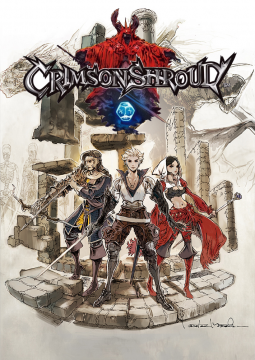
This is one of the most maturely written JRPGs I’ve ever played. The story isn’t the most engaging aspect of the game, but it kept me interested, and the writing is, as to be expected of Level-5, exceptionally localized. Once again, Crimson Shroud refuses to handhold and waste time explaining things best inferred. As if you’ve already adventured in this world before, the DM skimps on setting exposition to deliver a character-based tale that requires quite a bit of imagination to comprehend, and the ending provides an odd brand of closure. The narrative begins, most confusingly, in medias res and details the origins of magic in a strange realm.

In the case of Crimson Shroud, it even extends to the story. This arcane sort of gameplay, championed by games like Dark Souls, feels truly special. The DM has charts, tables, and enemy statistics printed on the inside of his DM’s screen, and the lack of transparency creates an atmosphere of magic and mystery.

What makes Crimson Shroud so special, however, is the information withheld from the player. A focus on status effects and stat-boosting and -lowering attacks makes combat even more idiosyncratic. Fighting the same battles while searching for the path ahead isn’t always fun, but finding new items and discovering new abilities makes it worthwhile. Like a proper adventure, some battles require almost no effort, a few are intimidatingly difficult, and most are somewhere in between: the perfect challenge. By limiting the number of attacks governed by dice rolls, however, the developers avoided gameplay overly reliant on chance. The element of luck never becomes obtrusive, although you can certainly feel out of control at times. The slow, strategic, occasionally random combat won’t please the impatient, but I was almost never frustrated or bored, and turn-based combat engines often have those effects on me. A minor crafting system complicates matters a tad, and monsters drop an immensely wide variety of items, making each fight uniquely rewarding. Thus, grinding in Crimson Shroud means searching for magic rings, healing items, and superior arms and armor. The three playable characters cannot gain levels, and so become more powerful by donning new equipment. Most of these abilities require a certain sum to succeed while others are more effective with higher dice totals. While not every attack requires a dice roll, some special abilities and other options prompt a roll of colorful polyhedral dice on the lower screen. Moments like these define Crimson Shroud’s unique identity as a virtual tabletop RPG.Ĭrimson Shroud renovates traditional turn-based combat by inserting a dice rolling mechanic and removing character levels. You might choose to flee over fight, for example, and then fickle fortune rears her ugly head as you roll the dice to determine your fate.
#Crimson shroud character art free
You’re free to explore, make mistakes, grind for items and equipment, and occasionally make decisions of relatively little import. He mostly leaves you to your own devices, however, and - with a baleful grin - sets his traps and sends legions of monsters marching into the dungeon. A nefarious Dungeon Master hides behind the upper screen of the 3DS to direct the action and provide the necessary story exposition and essential tutorials as well as a few kindly warnings. Classic game designers have never forgotten their history and, instead of never repeating it, Yasumi Matsuno sought to replicate it.Ĭrimson Shroud attempts to emulate the classic tabletop, pen-and-paper RPG experience, and the result is a curiously enchanting and effective simulation, if a simplified and overly brief one. Even in the East, the first RPGs, including titles like Final Fantasy, were influenced by games like Dungeons and Dragons. Although a few superstitious antiquaries keep these primitive forms of storytelling alive, there is now a much simpler and easier way to role-play. A Dungeon or Game Master presided over the action and gently or malevolently guided and misguided his players through harrowing episodes of adventure. Once, RPGs were played only on tabletops with pens, paper, dice, and a fathomless well of imagination. In an era of riskless sequels and aging IPs, Crimson Shroud is a refreshing curiosity imported from the Bazaar of the Bizarre. A low-budget RPG with inaccessible gameplay and experimental design doesn’t appear in the Nintendo eShop every day, but the reputations of Level-5 and Yasumi Matsuno (Final Fantasy Tactics, Vagrant Story) are evidently enough to warrant a North American release. Games like Crimson Shroud come as sudden, surprising blessings from the localization goddess.


 0 kommentar(er)
0 kommentar(er)
